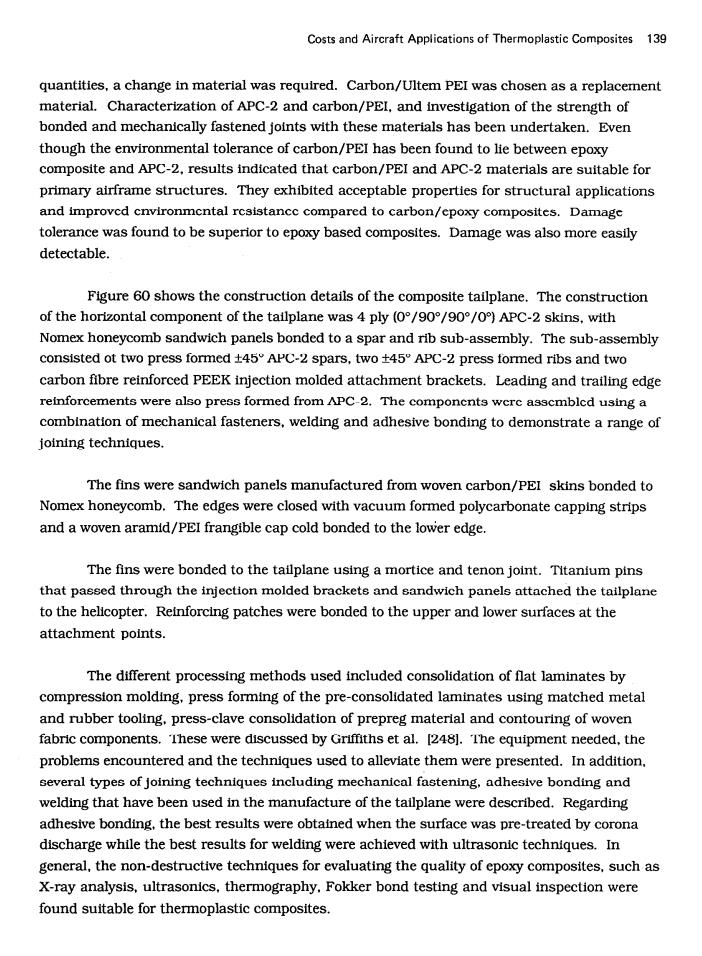正在加载图片...

Costs and Aircraft Applications of Thermoplastic Composites 139 quantities,a change in material was required.Carbon/Ultem PEI was chosen as a replacement material.Characterization of APC-2 and carbon/PEI,and investigation of the strength of bonded and mechanically fastened joints with these materials has been undertaken.Even though the environmental tolerance of carbon/PEI has been found to lie between epoxy composite and APC-2,results indicated that carbon/PEI and APC-2 materials are suitable for primary airframe structures.They exhibited acceptable properties for structural applications and improved cnvironmcntal rcsistancc compared to carbon/cpoxy composites.Damage tolerance was found to be superior to epoxy based composites.Damage was also more easily detectable. Figure 60 shows the construction details of the composite tailplane.The construction of the horizontal component of the tailplane was 4 ply (0/90/90/0)APC-2 skins,with Nomex honeycomb sandwich panels bonded to a spar and rib sub-assembly.The sub-assembly consisted ot two press formed t45 APC-2 spars,two t45 APC-2 press formed ribs and two carbon fibre reinforced PEEK injection molded attachment brackets.Leading and trailing edge reinforcements were also press formed from APC-2.The components werc asscmblcd using a combination of mechanical fasteners,welding and adhesive bonding to demonstrate a range of joining techniques. The fins were sandwich panels manufactured from woven carbon/PEI skins bonded to Nomex honeycomb.The edges were closed with vacuum formed polycarbonate capping strips and a woven aramid/PEI frangible cap cold bonded to the lower edge. The fins were bonded to the tailplane using a mortice and tenon joint.Titanfum pins that passed through the injection molded brackets and sandwich panels attached the tailplane to the helicopter.Reinforcing patches were bonded to the upper and lower surfaces at the attachment points. The different processing methods used included consolidation of flat laminates by compression molding,press forming of the pre-consolidated laminates using matched metal and rubber tooling.press-clave consolidation of prepreg material and contouring of woven fabric components.These were discussed by Griffiths et al.[248].The equipment needed,the problems encountered and the techniques used to alleviate them were presented.In addition. several types of joining techniques including mechanical fastening,adhesive bonding and welding that have been used in the manufacture of the tailplane were described.Regarding adhesive bonding,the best results were obtained when the surface was pre-treated by corona discharge while the best results for welding were achieved with ultrasonic techniques.In general,the non-destructive techniques for evaluating the quality of epoxy composites.such as X-ray analysis,ultrasonics.thermography.Fokker bond testing and visual inspection were found suitable for thermoplastic composites.Costs and Aircraft Applications of Thermoplastic Composites 139 quantities, a change in material was required. Carbon/Ultem PEI was chosen as a replacement material. Characterization of APC-2 and carbon/PEI, and investigation of the strength of bonded and mechanically fastened joints with these materials has been undertaken. Even though the environmental tolerance of carbon/PEI has been found to lie between epoxy composite and APC-2, results indicated that carbon/PEI and APC-2 materials are suitable for primary airframe structures. They exhibited acceptable properties for structural applications and improved environmental resistance compared to carbon/epoxy composites. Damage tolerance was found to be superior to epoxy based composites. Damage was also more easily detectable. Figure 60 shows the construction details of the composite tailplane. The construction of the horizontal component of the tailplane was 4 ply (O”/900/900/Oo) APC-2 skins, with Nomex honeycomb sandwich panels bonded to a spar and rib sub-assembly. The sub-assembly consisted ot two press formed +45’ APC-2 spars, two rt45” APC-2 press formed ribs and two carbon fibre reinforced PEEK injection molded attachment brackets. Leading and trailing edge reinforcements were also press formed from APC-2. The components were assembled using a combination of mechanical fasteners, welding and adhesive bonding to demonstrate a range of joining techniques. The fins were sandwich panels manufactured from woven carbon/PEI skins bonded to Nomex honeycomb. The edges were closed with vacuum formed polycarbonate capping strips and a woven aramid/PEI frangible cap cold bonded to the lotier edge. The fins were bonded to the tailplane using a mortice and tenon joint. Titanium pins that passed through the injection molded brackets and sandwich panels attached the tailplane to the helicopter. Reinforcing patches were bonded to the upper and lower surfaces at the attachment points. The different processing methods used included consolidation of flat laminates by compression molding, press forming of the pre-consolidated laminates using matched metal and rubber tooling, press-clave consolidation of prepreg material and contouring of woven fabric components. These were discussed by Griffiths et al. 12481. The equipment needed, the problems encountered and the techniques used to alleviate them were presented. In addition, several types of joining techniques including mechanical fastening, adhesive bonding and welding that have been used in the manufacture of the tailplane were described. Regarding adhesive bonding, the best results were obtained when the surface was pre-treated by corona discharge while the best results for welding were achieved with ultrasonic techniques. In general, the non-destructive techniques for evaluating the quality of epoxy composites, such as X-ray analysis, ultrasonics, thermography, Fokker bond testing and visual inspection were found suitable for thermoplastic composites